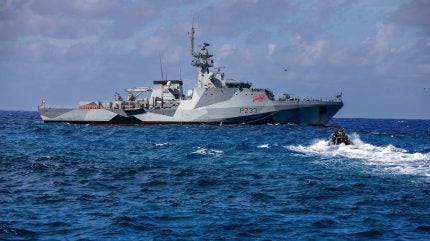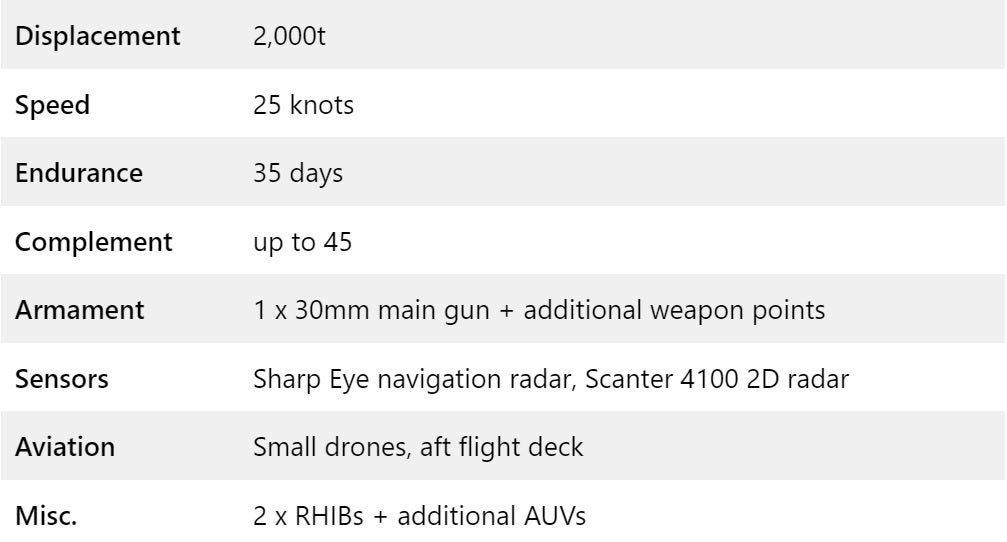
A series of releases highlighting the recent operations of the UK Royal Navy’s (RN) Batch 2 River-class offshore patrol vessels (OPVs) forward deployed to the Asia-Pacific region has served to demonstrate the military and diplomatic value they provide to the country’s global aspirations.
At a little over 90 metres in length and displacing around 2,000 tonnes, the Batch 2 River class are an evolution from the older Batch 1 – of which the RN operates three vessels – being larger and able to ‘lilly-pad’ maritime rotary wing aviation.
A total of five Batch 2 OPVs were built for the RN, and all are currently deployed at key locations around the world, with fixed deployments in the South Atlantic, Mediterranean, Caribbean, and Asia-Pacific.
Being forward deployed, the class will operate from a number of UK and allied naval facilities, such as Sembawang in Singapore for the two vessels (HMS Spey and HMS Tamar) positioned in the Asia-Pacific region. However, the vessels have no fixed base, rather operating from and undertaking sustainment processes at friendly shipyards.
Asia-Pacific: Tamar and Spey
Having set off from the UK in September 2021 bound for the Asia-Pacific region, HMS Tamar and HMS Spey have forward deployed for nearly three years, serving to provide a UK presence in waters that had previously been forgotten. This includes visits to the Pitcairn Islands, the sole British Overseas Territory in the Pacific.
HMS Spey recently completed a “detect rectification period” at Japan Marine United in Yokosuka, Japan, a process typical for the forward deployed River-class OPVs. The vessel has been in the Japanese area of operations for a couple of months, having arrived in Yokosuka in April as the first port visit under the Japan-UK Facilitation Agreement.
Following the rectification work, HMS Spey returned to maritime security operations with the Japanese Ministry of Defense stating the vessel had been conducting surveillance activities, including monitoring ship-to-ship transfers with North Korea-flagged vessels prohibited by UN Security Council resolutions in waters surrounding Japan from mid to late-June.
The surveillance patrol was the 12th time a UK RN vessel had conducted such operations since 2018, assisting significantly through the presence of forward deployed assets.
Meanwhile, HMS Tamar was most recently active in Australian waters, conducting a berthing ‘link-up’ alongside the US Navy submarine tender USS Emory S Land, and the Australian survey vessel HMAS Leeuwin.
The operation saw HMS Tamar and HMAS Leeuwin berth alongside USS Emory S Land, before ‘plugging in’ to the vessel’s fuel, water, and power supply.
The USS Emory S Land acts as a tender, also known as a ‘depot ship’ in the Royal Navy, providing forward support to US Navy hunter-killer nuclear submarines – electricity, water, consumables, spare parts, repairs, engineering assistance – and their crews – medical and dental aid, mail, food, administration – to sustain operations in the absence of a naval base.
Once Tamar was berthed, the River-class OPV was joined outboard by HMAS Leeuwin. Connections were subsequently made to prove that fuel, water, and electricity could be provided to both ships from the US tender, the UK Royal Navy stated in a 20 June 2024, release.
Cost effective maritime presence, in peacetime
The Batch 2 River-class OPVs followed on the from the smaller Batch 1 design, with the latter class originally conceived as fisheries protection vessels, one of the oldest roles of the UK Royal Navy.
However, the larger Batch 2 vessels offered improved seakeeping capabilities and as such have found themselves used as forward deployed maritime presence platforms in areas where the UK has a military or diplomatic interest.
With minimal armament – just a single 30mm main gun and a number of smaller calibre weapon systems are fitted – the class are intended for the very lightest of maritime security roles, tracking smuggling, fisheries protection, and undertaking exercises with friendly navies.
River-class Batch 2 OPV – specifications

The two variant class, Batch 1 and Batch 2, are also exceedingly cost effective, with the total running cost of the three remaining Batch 1 (HMS Mersey, HMS Severn, and HMS Tyne) and five Batch 2 vessels (HMS Tamar, HMS Spey, HMS Trent, HMS Medway, HMS Forth) in FY2022-2023 just £54m (68.3m), reducing maintenance costs further to £51.25m for FY2022-2023, according to official figures from February 2024.
The first three in class – Forth, Trent, and Medway – entering into RN service from 2017-2020, with Tamar and Spey following in the build of a second batch of Batch 2 OPVs in 2020-2021.
Based on the Amazonas-class patrol vessels originally built by BAE Systems for the Trinidad and Tobago Coast Guard but subsequently acquired by Brazil, the Batch 2 River class were manufactured to more stringent naval standards.





